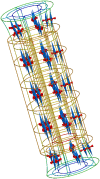Using CellML with OpenCMISS to Simulate Multi-Scale Physiology
- PMID: 25601911
- PMCID: PMC4283644
- DOI: 10.3389/fbioe.2014.00079
Using CellML with OpenCMISS to Simulate Multi-Scale Physiology
Abstract
OpenCMISS is an open-source modeling environment aimed, in particular, at the solution of bioengineering problems. OpenCMISS consists of two main parts: a computational library (OpenCMISS-Iron) and a field manipulation and visualization library (OpenCMISS-Zinc). OpenCMISS is designed for the solution of coupled multi-scale, multi-physics problems in a general-purpose parallel environment. CellML is an XML format designed to encode biophysically based systems of ordinary differential equations and both linear and non-linear algebraic equations. A primary design goal of CellML is to allow mathematical models to be encoded in a modular and reusable format to aid reproducibility and interoperability of modeling studies. In OpenCMISS, we make use of CellML models to enable users to configure various aspects of their multi-scale physiological models. This avoids the need for users to be familiar with the OpenCMISS internal code in order to perform customized computational experiments. Examples of this are: cellular electrophysiology models embedded in tissue electrical propagation models; material constitutive relationships for mechanical growth and deformation simulations; time-varying boundary conditions for various problem domains; and fluid constitutive relationships and lumped-parameter models. In this paper, we provide implementation details describing how CellML models are integrated into multi-scale physiological models in OpenCMISS. The external interface OpenCMISS presents to users is also described, including specific examples exemplifying the extensibility and usability these tools provide the physiological modeling and simulation community. We conclude with some thoughts on future extension of OpenCMISS to make use of other community developed information standards, such as FieldML, SED-ML, and BioSignalML. Plans for the integration of accelerator code (graphical processing unit and field programmable gate array) generated from CellML models is also discussed.
Keywords: CellML; OpenCMISS; multi-scale physiological model; physiome project; virtual physiological human.
Figures








Similar articles
-
OpenCMISS: a multi-physics & multi-scale computational infrastructure for the VPH/Physiome project.Prog Biophys Mol Biol. 2011 Oct;107(1):32-47. doi: 10.1016/j.pbiomolbio.2011.06.015. Epub 2011 Jul 7. Prog Biophys Mol Biol. 2011. PMID: 21762717
-
CellML 2.0.J Integr Bioinform. 2020 Jul 24;17(2-3):20200021. doi: 10.1515/jib-2020-0021. J Integr Bioinform. 2020. PMID: 32759406 Free PMC article.
-
Modeling the chemoelectromechanical behavior of skeletal muscle using the parallel open-source software library OpenCMISS.Comput Math Methods Med. 2013;2013:517287. doi: 10.1155/2013/517287. Epub 2013 Nov 17. Comput Math Methods Med. 2013. PMID: 24348739 Free PMC article.
-
CellML and associated tools and techniques.Philos Trans A Math Phys Eng Sci. 2008 Sep 13;366(1878):3017-43. doi: 10.1098/rsta.2008.0094. Philos Trans A Math Phys Eng Sci. 2008. PMID: 18579471 Review.
-
Practical application of CellML 1.1: The integration of new mechanisms into a human ventricular myocyte model.Prog Biophys Mol Biol. 2008 Sep;98(1):38-51. doi: 10.1016/j.pbiomolbio.2008.05.006. Epub 2008 Jun 23. Prog Biophys Mol Biol. 2008. PMID: 18606438 Review.
Cited by
-
The virtual intestine: in silico modeling of small intestinal electrophysiology and motility and the applications.Wiley Interdiscip Rev Syst Biol Med. 2016 Jan-Feb;8(1):69-85. doi: 10.1002/wsbm.1324. Epub 2015 Nov 12. Wiley Interdiscip Rev Syst Biol Med. 2016. PMID: 26562482 Free PMC article. Review.
-
Assessing Cardiomyocyte Excitation-Contraction Coupling Site Detection From Live Cell Imaging Using a Structurally-Realistic Computational Model of Calcium Release.Front Physiol. 2019 Oct 2;10:1263. doi: 10.3389/fphys.2019.01263. eCollection 2019. Front Physiol. 2019. PMID: 31632297 Free PMC article.
-
Roadmap for cardiovascular circulation model.J Physiol. 2016 Dec 1;594(23):6909-6928. doi: 10.1113/JP272660. Epub 2016 Sep 29. J Physiol. 2016. PMID: 27506597 Free PMC article.
-
Computational Modeling of Glucose Uptake in the Enterocyte.Front Physiol. 2019 Apr 12;10:380. doi: 10.3389/fphys.2019.00380. eCollection 2019. Front Physiol. 2019. PMID: 31031632 Free PMC article.
-
Requirements for the formal representation of pathophysiology mechanisms by clinicians.Interface Focus. 2016 Apr 6;6(2):20150099. doi: 10.1098/rsfs.2015.0099. Interface Focus. 2016. PMID: 27051514 Free PMC article.
References
Grants and funding
LinkOut - more resources
Full Text Sources
Other Literature Sources

